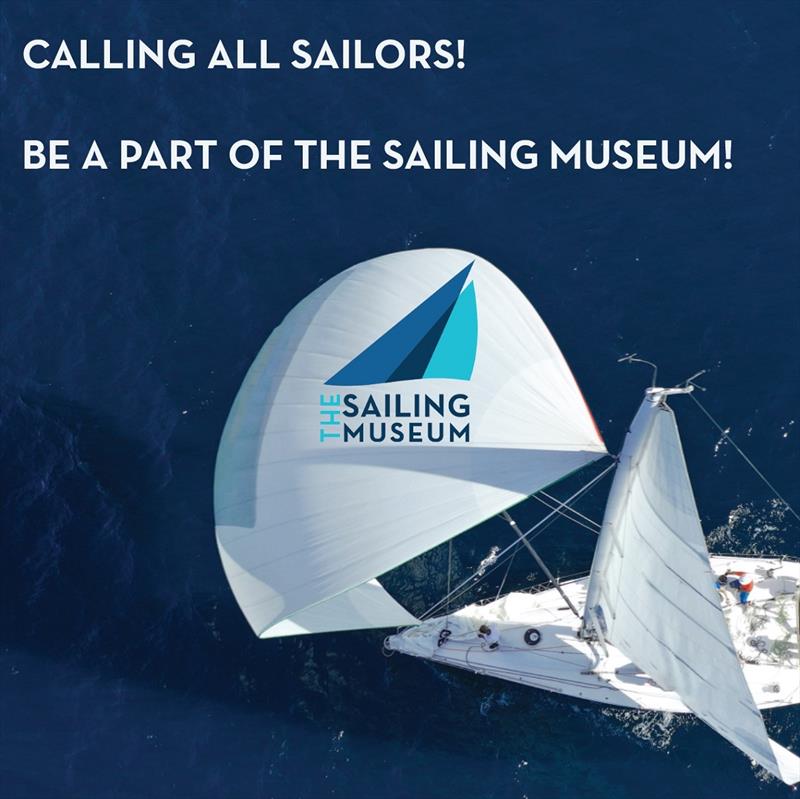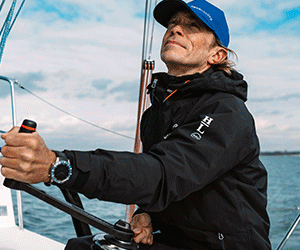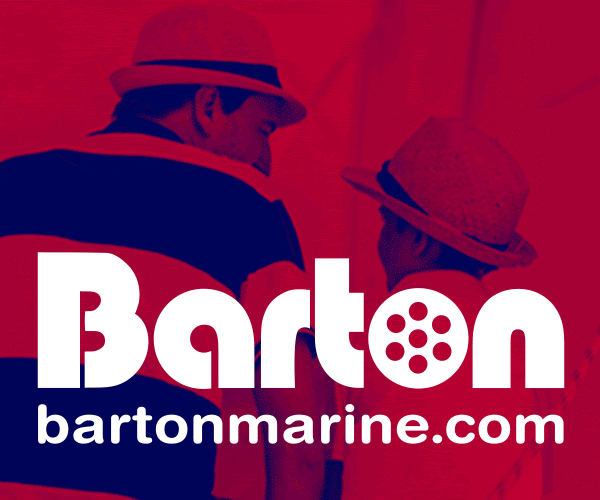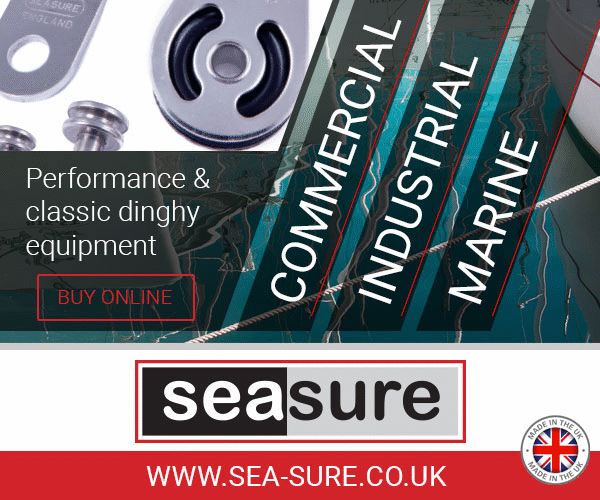
An interview with Heather Ruhsam on The Sailing Museum’s grand opening
by David Schmidt 12 May 08:00 PDT
May 12, 2022

The Sailing Museum announces opportunity to be part of exhibit © Andrew Golden
It’s not every day that the sport we all love best opens the doors on a museum dedicated to preserving and celebrating sailing, but this is exactly what happened in Newport, Rhode Island, on May 10, 2022, when The Sailing Museum began welcoming the public into its halls. The Sailing Museum (TSM) is based in Newport’s historic Armory Building, which was built in 1894, and it also features exhibits honoring the National Sailing Hall of Fame (NSHOF) and the Americas Cup Hall of Fame (ACHOF), the latter two of which are housed in TSM’s Legends of Sailing area.
While celebrating the past is important (I’ll come clean: I’ve served on the NSHOF Selection Committee for several years), so, too, is the opportunity to open visitors’ eyes to the possibilities that sailing affords. To this end, TSM features a diverse range of exhibits, including Wind & Water, The Making of a Sailor: Mental, The Making of a Sailor: Physical, Teamwork, and Competition, as well as avatars that help guide visitors through their experience.
Additionally, visitors can also expect a Science, Technology, Engineering, Art and Math (STEAM) experience that’s tied to sailing.
I checked in with Heather Ruhsam, executive director of The Sailing Museum, via email, to learn more about this exciting new institution.
How many years has the TSM’s physical building been in the planning/designing/building phase?
The purchase of the building closed in March of 2019, and shortly after the design and planning process started. We worked with the Rhode Island Historical Preservation and Heritage Commission on exterior improvements to the building, including the addition of doors and windows along the west side, which now provide a year-round sunset view over Newport Harbor.
The building has been modernized to support the multi-media museum experience and welcome our visitors and meet their needs.
How was Newport selected as the location? I’m sure there were some sad sailors in Annapolis when news broke that Newport was the winner…?
In 2017, the then Mayor of Newport spoke with one of our Board Members about the possibility of the historic Armory building. With its rich history and use as the press office during the 12 mR era of the America’s Cup in Newport, there is a relevance to the space for our sport.
The board analyzed the opportunity here alongside that of the property in Annapolis. The location, size and design of the property and potential for attendance made the Newport Armory an outstanding home for the museum.
While there was definitely some disappointment when the move was announced, it did have the support of board members from Annapolis, Newport and across the country.
Can you please give us an overview of the kinds of things people will see if they visit the TSM?
There’s a mix of high and low-tech exhibits that share the ins-and-outs of the sport.
The artifacts are almost exclusively from the collections of the Hall of Famers, providing an incredible lens through which to learn about the sport and the personalities behind it.
The museum is divided into six themed areas that explore the sport. Within those there are Olympic medals, paintings, charts that have been taken around the world, boat building tools and so much more. It’s pretty neat to see what are essentially the inner workings of the sport displayed throughout the museum and share with people all that goes into the boat they see sailing by on [Narragansett Bay].
Building on that last question, what kind of multi-media, STEAM, or interactive media can visitors look forward to checking out? What about historic memorabilia, say in the NSHOF or the ACHOF?
Layered into the experience is a personalized visitor journey through a series of interactive exhibits.
People can select one of seven boats that becomes their identifier, or avatar, in the museum, connecting the different activities—from designing boats and burgees to testing their knowledge of iconic races, steering with both tiller and wheel and a number of others. Educational elements are embedded in nearly everything in the museum.
Think of it as ‘stealth learning – you’re having fun and learning something! What’s great about that is it allows us to build more robust learning programs with educational partners for field trips and school groups.
What kind of experience do you hope a visit to the TSM will provide for a family with young kids? What about take-away messages about the sport of sailing, its accessibility, and DEI?
The Sailing Museum is fueled by the DNA of the National Sailing Hall of Fame, which from early days has envisioned an America where people of all ages, backgrounds and abilities can participate in sailing.
Throughout the museum we share that sailing happens everywhere and is for everyone. Imagery shows people of different abilities, genders, ages and races participating in a sport that includes diverse boats and geographic locations.
The experience has been designed to offer something to everyone in a multi-generational family-think if it as a sailing arcade for the kids and a place to revel in the history and icons of our sport for their parents and grand-parents. All this is a space that is both welcoming and inclusive. One that presents sailing in an approachable manner and inspires new generations of sailors, innovators, authors and artists.
We live in an increasingly virtual world. Why is it important for TSM (and the NSHOF and the ACHOF) to have a brick-and-mortar facility?
So much of sailing is about camaraderie and the relationships you build on the water. It is as much about social and emotional lessons as the physical and scholastic ones. Sailing brings people together. And while we can gather virtually (as we have so extensively over the last couple of years!), a physical location allows people to get a taste of all that sailing offers in a far more tangible way.
While I consider myself a sailor, I also recall feeling intimidated by aspects of the sport, the language and the skill involved. If we want to get more people into sailing, we need to break down some of the barriers to participation, even those that may be preconceptions or stereotypes of “who” sailing is or isn’t for. The museum offers an access point for people to learn about the sport, about its history, about the different types of boats and places to sail.
Industry and community collaborators who are sailing experts helped us to bring authenticity to the subject matter and exhibits-in the process sharing their own passion for sailing, which we then get to share with our visitors. The museum activities excite people about the sport, show that that anyone can sail and then provide them the resources to get started themselves.
A big part of what we get to do through the museum is support the sport, grow participation and get more people into sailing and all that it offers on the water and off. That is something that isn’t as easily done in a virtual format.
I realize that the TSM is a museum dedicated to the history and magic of sailing, but I’m wondering what kind of an environmental message you and the other directors are trying to instill in visitors? Also, do any of the exhibits or displays directly address climate change and the amount of plastic in the ocean? If not, what’s the plan to add some kind f environmental awareness to the TSM visitor experience?
Before this role, I spent the better part of the last 12 years in the nonprofit environmental space and ocean stewardship is a topic near and dear.
In the Wind & Water area of the museum there is messaging about the environment, the places we sail and the protection of them. This includes a crowd-sourced video of sailors from across the country sharing what they do to protect the waters they sail on. As we develop our educational materials, this messaging will be reinforced and supplemented with resources and activities that can be done after visitors leave the museum.
We may not be able to cover everything in the 8,500 sq/ft of exhibit space, but we can point people in the direction of resources to learn more and get involved. Sparking interest and providing a way to continue learning after every visit is an important feature across the museum.
Is there anything else that you’d like to add, for the record?
We like to say “we believe” sailing has something for everyone. We believe it can inspire, excite, teach, engage, include and transform. We believe it can change lives, open minds, develop skills and create opportunities. We believe those who walk through these doors – sailors and non-sailors alike – will have an extraordinary experience and understand why we love this sport – and those who ply it – so much. We hope they will emerge as believers, too.




